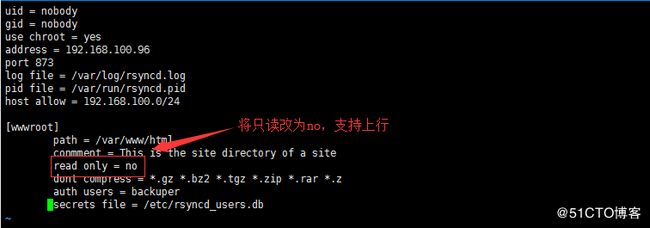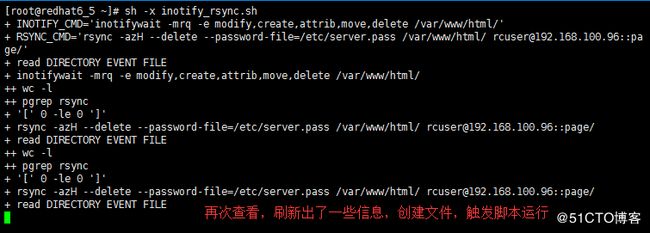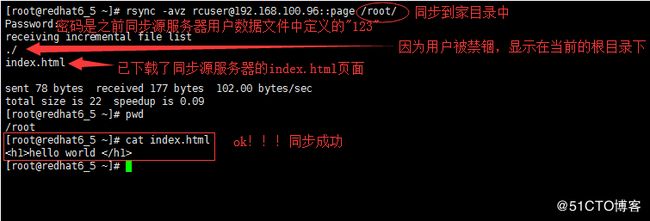rsync+inotify实时同步案例
随着应用系统规模的不断扩大,对数据的安全性和可靠性也提出的更好的要求,rsync在高端业务系统中也逐渐暴露出了很多不足,首先,rsync同步数据时,需要扫描所有文件后进行比对,进行差量传输。如果文件数量达到了百万甚至千万量级,扫描所有文件将是非常耗时的。而且正在发生变化的往往是其中很少的一部分,这是非常低效的方式。其次,rsync不能实时的去监测、同步数据,虽然它可以通过linux守护进程的方式进行触发同步,但是两次触发动作一定会有时间差,这样就导致了服务端和客户端数据可能出现不一致,无法在应用故障时完全的恢复数据。基于以上原因,rsync+inotify组合出现了!
1.1 inotify介绍
2.1 rsync+inotify同步逻辑图
3.1 环境部署
4.1 inotify-slave部署
4.1.1检查是否安装rsync
4.1.2 新建rsync用户及模块目录并更改其用户组
4.1.3 编写rsync daemon配置文件/etc/rsyncd.conf
4.1.4 配置虚拟用户的密码文件
4.1.5 启动rsync 服务
4.1.6 通过inotify-master测试推送
5.1 inotify-master部署
5.1.1 查看当前系统是否支持inotify
5.1.2 inotify安装
5.1.3 inotify之inotifywait命令常用参数详解
5.1.4 编写监控脚本并加载到后台执行
5.1.5 实时同步测试
1.1 inotify介绍
inotify是一种强大的、细粒度的、异步的文件系统事件控制机制。linux内核从2.6.13起,加入了inotify支持,通过inotify可以监控文件系统中添加、删除、修改、移动等各种事件,利用这个内核接口,第三方软件就可以监控文件系统下文件的各种变化情况,而inotify-tools正是实施监控的软件。
2.1基本架构
3.1 基本环境部署(这里为了避免不兼容的情况出现,采用统一版本的系统)
| 主机名 | IP地址 | 系统版本 | 内核版本 |
|---|---|---|---|
| inotify master | 192.168.42.116 | centos 6.8 | 2.6.32-642.el6.x86_64 |
| inotify slave | 192.168.42.112 | centos 6.8 | 2.6.32-642.el6.x86_64 |
4.1 inotify-slave部署
这里就是部署rsync服务,rsync daemon工作模式。
4.1.1检查是否安装rsync
rpm -qa rsync
结果
4.1.2 新建rsync用户及模块目录并更改其用户组
useradd rsync -s /sbin/nologin -M mkdir /backup #创建rsync daemon工作模式的模块目录chown rsync.rsync /backup/ #更改模块目录的用户组ll -d /backup/
4.1.3 编写rsync daemon配置文件/etc/rsyncd.conf
##rsyncd.conf start## #工作中指定用户(需要指定用户) uid = rsync gid = rsync #相当于黑洞.出错定位 use chroot = no #有多少个客户端同时传文件 max connections = 200 #超时时间 timeout = 300 #进程号文件 pid file = /var/run/rsyncd.pid #锁文件 lock file = /var/run/rsync.lock #日志文件 log file = /var/log/rsyncd.log #模块开始 #这个模块对应的是推送目录#模块名称随便起[backup]#需要同步的目录path = /backup/ #表示出现错误忽略错误 ignore errors #表示网络权限可写(本地控制真正可写)read only = false #这里设置IP或让不让同步list = false #指定允许的网段 hosts allow = 192.168.42.0/24 #拒绝链接的地址,一下表示没有拒绝的链接。 hosts deny = 0.0.0.0/32#不要动的东西(默认情况) #虚拟用户 auth users = root #虚拟用户的密码文件secrets file = /etc/rsync.password #配置文件的结尾#rsync_config_______________end
4.1.4 配置客户端及虚拟inotify-backup用户的密码文件
echo "root:123456" >/etc/rsync.password #注:这里是客户端,密码文件得写全,root为rsync同步使用的用户,123456为这个虚拟用户的密码 chmod 600 /etc/rsync.password #为密码文件提权,增加安全性
4.1.5 启动rsync 服务
rsync --daemon #启动rsync服务ps -ef |grep rsync root 2389 1 0 10:15 ? 00:00:00 rsync --daemon root 2392 2305 0 10:15 pts/0 00:00:00 grep rsync ss -tunl tcp LISTEN 0 5 :::873 :::* tcp LISTEN 0 5 *:873 *:*
4.1.6 通过inotify-master测试推送
inotify-master配置密码文件,测试推送
echo "123456" >/etc/rsync.password #注意:服务器端只要写密码即可,切记。 chmod 600 /etc/rsync.password echo "hello sjf">test.txt rsync -avz test.txt [email protected]::backup --password-file=/etc/rsync.password sending incremental file list test.txt sent 79 bytes received 27 bytes 42.40 bytes/sec total size is 10 speedup is 0.09inotify-slave检查: ll /backup/ total 4-rw-r--r-- 1 rsync rsync 10 Oct 29 10:20 test.txt cat /backup/test.txt hello sjf
5.1 inotify-master部署
注:
inotify是rsync客户端安装和执行的
企业场景压力测试200-300个同步限制,受网卡,磁盘,带宽等的制约。
5.1.1 查看当前系统是否支持inotify
ll /proc/sys/fs/inotify/ total 0-rw-r--r-- 1 root root 0 Oct 29 10:43 max_queued_events -rw-r--r-- 1 root root 0 Oct 29 10:43 max_user_instances -rw-r--r-- 1 root root 0 Oct 29 10:43 max_user_watches#显示这三个文件则证明支持。番外: /proc/sys/fs/inotify/max_queued_evnets 表示调用inotify_init时分配给inotify instance中可排队的event的数目的最大值,超出这个值的事件被丢弃,但会触发IN_Q_OVERFLOW事件。 /proc/sys/fs/inotify/max_user_instances 表示每一个real user ID可创建的inotify instatnces的数量上限。 /proc/sys/fs/inotify/max_user_watches 表示每个inotify instatnces可监控的最大目录数量。如果监控的文件数目巨大,需要根据情况,适当增加此值的大小。 例如: echo 30000000 > /proc/sys/fs/inotify/max_user_watches
5.1.2 inotify的安装
inotify可以编译安装也可以直接yum安装 我这里采用的是yum安装的方式 yum -y install inotify-tools 当然我这里也给出编译安装的方法 wget http://jaist.dl.sourceforge.net/project/inotify-tools/inotify-tools/3.13/inotify-tools-3.13.tar.gz tar zxf inotify-tools-3.14.tar.gzcd inotify-tools-3.14./configure --prefix=/usr/local/inotify-3.14 #配置inotify,并指定安装路径为/usr/local/inotify-3.14make && make install 注意这里安装完成后记得将命令所在路径引入环境变量
5.1.3 inotify之inotifywait命令常用参数详解
inotifywait --help -r|--recursive Watch directories recursively. #递归查询目录-q|--quiet Print less (only print events). #打印监控事件的信息-m|--monitor Keep listening for events forever. Without this option, inotifywait will exit after one event is received. #始终保持事件监听状态--excludeiLike --exclude but case insensitive. #排除文件或目录时,不区分大小写。--timefmt strftime-compatible format string for use with %T in--format string. #指定时间输出的格式--format Print using a specified printf-like format string; read the man page for more details. #打印使用指定的输出类似格式字符串-e|--event [ -e|--event ... ] Listen for specific event(s). If omitted, all events are listened for. #通过此参数可以指定需要监控的事件如下所示: Events: access file or directory contents were read #文件或目录被读取。modify file or directory contents were written #文件或目录内容被修改。attrib file or directory attributes changed #文件或目录属性被改变。close file or directory closed, regardless of read/write mode #文件或目录封闭,无论读/写模式。open file or directory opened #文件或目录被打开。moved_to file or directory moved to watched directory #文件或目录被移动至另外一个目录。 move file or directory moved to or from watched directory #文件或目录被移动另一个目录或从另一个目录移动至当前目录。 create file or directory created within watched directory #文件或目录被创建在当前目录delete file or directory deleted within watched directory #文件或目录被删除 unmount file system containing file or directory unmounted #文件系统被卸载
5.1.4 编写监控脚本并加载到后台执行
#!/bin/bash#sjfhost01=192.168.42.116
#inotify-slave的ip地址src=/backup/
#本地监控的目录dst=backup
#inotify-slave的rsync服务的模块名user=rsync_backup
#inotify-slave的rsync服务的虚拟用户rsync_passfile=/etc/rsync.password
#本地调用rsync服务的密码文件#inotify_home=/usr/share/doc/inotify-3.14
#inotify的安装目录inotify_home=/usr
#这个是yum安装的软件的安装所在目录#judgeif [ -z "$src" ] \
|| [ -z "${rsync_passfile}" ] \
|| [ -z "${inotify_home}/bin/inotifywait" ] \
|| [ -z "/usr/bin/rsync" ];thenecho "Check File and Folder"
exit 9
fi
${inotify_home}/bin/inotifywait -mrq --timefmt '%d/%m/%y %H:%M'
--format '%T %w%f' -e close_write,delete,create,attrib $src \
| while read filedo# rsync -avzP --delete --timeout=100
--password-file=${rsync_passfile} $src $user@$host01::$dst >/dev/null 2>&1cd $src
&& rsync -aruz -R --delete ./ --timeout=100 $user@$host01::$dst
--password-file=${rsync_passfile} >/dev/null 2>&1doneexit 0
#将脚本加入后台执行
bash inotify.sh &
[1] 3357
5.1.5 实时同步测试
inotify-master操作:
cd /backup/for i in `seq 200`;do touch $i ;done #创建200个文件ls -l --time-style=full-iso total 0 -rw-r--r-- 1 root root 0 2016-10-29 11:38:16.183409656 +0800 1 -rw-r--r-- 1 root root 0 2016-10-29 11:38:16.225409783 +0800 10 -rw-r--r-- 1 root root 0 2016-10-29 11:38:16.526410667 +0800 100 -rw-r--r-- 1 root root 0 2016-10-29 11:38:16.528410673 +0800 101 -rw-r--r-- 1 root root 0 2016-10-29 11:38:16.530410679 +0800 102 -rw-r--r-- 1 root root 0 2016-10-29 11:38:16.533410688 +0800 103 -rw-r--r-- 1 root root 0 2016-10-29 11:38:16.535410694 +0800 104 -rw-r--r-- 1 root root 0 2016-10-29 11:38:16.538410703 +0800 105 -rw-r--r-- 1 root root 0 2016-10-29 11:38:16.539410707 +0800 106 -rw-r--r-- 1 root root 0 2016-10-29 11:38:16.552410742 +0800 107
inotify-slave检查
ll --time-style=full-iso total 0 -rw-r--r-- 1 rsync rsync 0 2016-10-29 11:38:16.000000000 +0800 1 -rw-r--r-- 1 rsync rsync 0 2016-10-29 11:38:16.000000000 +0800 10 -rw-r--r-- 1 rsync rsync 0 2016-10-29 11:38:16.000000000 +0800 100 -rw-r--r-- 1 rsync rsync 0 2016-10-29 11:38:16.000000000 +0800 101 -rw-r--r-- 1 rsync rsync 0 2016-10-29 11:38:16.000000000 +0800 102 -rw-r--r-- 1 rsync rsync 0 2016-10-29 11:38:16.000000000 +0800 103 -rw-r--r-- 1 rsync rsync 0 2016-10-29 11:38:16.000000000 +0800 104 -rw-r--r-- 1 rsync rsync 0 2016-10-29 11:38:16.000000000 +0800 105 -rw-r--r-- 1 rsync rsync 0 2016-10-29 11:38:16.000000000 +0800 106 -rw-r--r-- 1 rsync rsync 0 2016-10-29 11:38:16.000000000 +0800 107 -rw-r--r-- 1 rsync rsync 0 2016-10-29 11:38:16.000000000 +0800 108
这样我们结合inotify的测试就完成了,是不是很简单!
超详细CentOS6.5配置rsync+inotify实现同步
rsync是一个开源的快速备份工具,可以在不同主机之间镜像同步整个目录树,支持增量备份,保持链接和权限,且采用优化的同步算法,传输前执行压缩,因此非常适用于异地备份、镜像服务器等应用
下行同步
在远程同步任务中,负责发起rsync同步操作的客户机称为发起端
而负责响应来自客户机的rsync同步操作的服务器称为同步源
在同步过程中,同步源负责提供文档的原始位置,发起端应对该位置具有读取权限
inotify是一个Linux特性,它监控文件系统操作,比如读取、写入和创建。inotify反应灵敏,用法非常简单,并且比cron任务的繁忙轮询高效得多。将rsync工具与inotify机制相结合,可以实现实时同步,只要原始位置发生变化,就立即启动增量备份操作,否则处于静默等待状态,这样避免了按固定周期备份时存在的延时性、周期过密性等问题
实验环境
系统环境:centos6.5
同步源IP:192.168.100.96/24
同步源主机名:redhat6_4
发起端IP:192.168.100.97/24
发起端主机名:redhat6_5
共享模块站点:/var/www/html
搭建步骤:
一、准备工作
1、同步源端、发起关闭防火墙、Selinux
[root@redhat6_4 ~]# vim /etc/sysconfig/selinux
[root@redhat6_4 ~]# chkconfig iptables off #开机启动关闭防火墙
二、配置同步源服务器
1、建立并编辑主配置文件
[root@redhat6_4 ~]# rpm -qa | grep 'rsync'
[root@redhat6_4 html]# vim /etc/rsyncd.conf #centos6中,配置文件需要手工建立,但是在centos7中系统事先已经建立
全局配置
uid = nobody #指定执行用户(系统伪用户)
gid = nobody #指定用户组
use chroot = yes #将用户禁锢在当前目录下(源目录)
address = 192.168.100.96 #服务器监听地址
port 873 #服务端口
log file = /var/log/rsyncd.log #日志存放位置
pid file = /var/run/rsyncd.pid #进程ID文件存放位置
host allow = 192.168.100.0/24 #允许访问的客户端地址模块定义
[page] #共享模块名称
path = /var/www/html #共享目录的实际路径
conmment = This is the site directory of a site #描述信息
read only = yes #是否为只读文件,yes代表只读,反之可以写,这里暂时制作备份,定义"yes"即可
dont compress = .gz .bz2 .tgz .zip .rar .z #同步时不再压缩的文件类型
auth users = rcuser #指定授权账户,如果多个用户以空格进行分割,此用户不是系统用户,只是指定一个专门进行的备份的一个账户而已
secrets file = /etc/rsyncd_users.db #存放账户信息的数据文件
2、建立并编辑账户数据文件
[root@redhat6_4 ~]# vim /etc/rsyncd_users.db
[root@redhat6_4 ~]# chmod 600 /etc/rsyncd_users.db #修改权限,这里必须改,否则客户端远程同步会报错,认证有问题,亲测!!!
3、同步源安装httpd并写入测试文件
[root@redhat6_4 ~]# yum -y install httpd[root@redhat6_4 ~]# /etc/init.d/httpd start[root@redhat6_4 ~]# cd /var/www/html/[root@redhat6_4 html]# rm -rf *[root@redhat6_4 html]# echo "hello world
" > index.html[root@redhat6_4 html]# chmod 777 /var/www/html/ #修改权限最大化,方便测试
4、启动rsync服务
[root@redhat6_4 ~]# rsync --daemon[root@redhat6_4 ~]# netstat -anpt | grep ":873"
三、发起端使用rsync备份工具进行下行同步
1、使用rsync命令实现下行同步
[root@redhat6_5 ~]# rsync -avz [email protected]::page /root/ #访问同步源模块page,下载到本地/root目录下进行备份
参数解析:
-r:递归模式,包含目录及子目录中的所有文件
-l:对于符号链接文件仍然复制为符号链接文件(软链接)
-v:显示同步过程的详细(verbose)信息
-a:归档模式,保留文件的权限、属性等信息,等同于组合选项"-rlptgoD"
-z:在传输文件时进行压缩(compress)
-p:保留文件的权限标记
-t:保留文件的时间标记
-g:保留文件的属组标记(仅超级用户使用)
-o:保留文件的属主标记(仅超级用户使用)
-H:保留硬连接文件
-A:保留ACL属性信息
-D:保留设备文件及其他特殊文件
--delete:删除目标位置有而原始位置没有的文件
--checksum:根据校验和(而不是文件大小、修改时间)来决定是否跳过文件
[root@redhat6_5 ~]# mkdir /opt/pub [root@redhat6_5 ~]# rsync -avz rsync://[email protected]/page /opt/pub/ #再次请求同步源服务将页面备份到/opt/pub/下
2、删除同步源服务器共享模块文件测试
[root@redhat6_4 ~]# cd /var/www/html/[root@redhat6_4 html]# rm -rf *[root@redhat6_4 html]# echo "123" > file1#写入测试文件[root@redhat6_4 html]# echo "456" > file2
3、发起端再次发起下行同步
[root@redhat6_5 ~]# rsync -avzH --delete [email protected]::page /opt/pub/
4、引入周期性计划任务,通过免密访问进行同步管理
[root@redhat6_5 ~]# vim /etc/server.pass #创建用户密码文件
[root@redhat6_5 ~]# chmod 600 /etc/server.pass #密码文件权限最小化,否则报错[root@redhat6_5 ~]# crontab -e
[root@redhat6_5 ~]# /etc/init.d/crond restart[root@redhat6_5 ~]# chkconfig crond on
四、配置rsync+inotify实时同步
1、调整inotify内核参数
[root@redhat6_5 ~]# vim /etc/sysctl.conf
添加以下参数
fs.inotify.max_queued_events = 16384 #监控事件队列
fs.inotify.max_user_instances = 1024 #最多监控实例数
fs.inotify.max_user_watches = 1048576 #每个实例最多监控文件数
[root@redhat6_5 ~]# sysctl -p #重新刷新文件
2、安装inotify-tools
[root@redhat6_5 ~]# yum -y install gcc gcc-c++ #安装编译器[root@redhat6_5 ~]# tar xvfz inotify-tools-3.14.tar.gz #解压[root@redhat6_5 ~]# cd inotify-tools-3.14 [root@redhat6_5 inotify-tools-3.14]# ./configure #配置[root@redhat6_5 inotify-tools-3.14]# make && make install #编译及编译安装
3、使用inotifywait命令进行监控测试
[root@redhat6_5 ~]# inotifywait -mrq -e modify,create,move,delete /var/www/html #对本地网站目录进行递归式实时监控,监控的事件包括修改、创建、移动、删除……
-m:持续的进行监控
-r:递归整个目录
-q:简化
-e:指定监控的事件
modify:修改
create:创建
move:移动
delete:删除
attrib:属性更改
/var/www/html:对此目录进行监控
4、对网站目录内容进行增、删、改、移
[root@redhat6_5 ~]# cd /var/www/html/ [root@redhat6_5 html]# touch abc.txt #创建测试文件[root@redhat6_5 html]# echo "12345" > abc.txt #修改测试文件内容[root@redhat6_5 html]# mv abc.txt fgh.txt #修改测试文件名称[root@redhat6_5 html]# rm -rf fgh.txt #删除测试文件
5、查看监控信息
6、编写触发式同步脚本(将本地站点文件上行源端)
[root@redhat6_5 ~]# vim inotify_rsync.sh
#!/bin/bash
INOTIFY_CMD="inotifywait -mrq -e modify,create,attrib,move,delete /var/www/html/"
RSYNC_CMD="rsync -azH --delete --password-file=/etc/server.pass /var/www/html/ [email protected]::page/"
$INOTIFY_CMD | while read DIRECTORY EVENT FILE
do
if [ $(pgrep rsync | wc -l) -le 0 ] ; then
$RSYNC_CMD
fi
done解析脚本:
①.INOTIFY_CMD:执行实时监控
②.RSYNC_CMD:将本地网站目录上行到源端
③.DIRECTORY EVENT FILE指动态监控的信息赋予给这三个变量变量
DIRECTORY :目录,输出的是/var/www/html
EVENT :发生事件,输出的是如create、modify、move……
FILE:文件的名称,输出的是修改、新建的文件名称
④.循环判断此时此刻rsync是否在运行,如果没有,将本地网站目录上行至源端
[root@redhat6_5 ~]# chmod +x inotify_rsync.sh #添加执行权限[root@redhat6_5 ~]# echo '/root/inotify_rsync.sh' >> /etc/rc.local #将输出追加至/etc/rc.local中
7、修改同步源配置文件
[root@redhat6_4 ~]# vim /etc/rsyncd.conf
[root@redhat6_4 run]# kill -9 $(cat /var/run/rsyncd.pid) #杀死rsync进程[root@redhat6_4 run]# rm -rf /var/run/rsyncd.pid #必须删除进程文件,再次启动,系统自动生成[root@redhat6_4 ~]# rsync --daemon #启动rsync
[root@redhat6_4 ~]# ll -d /var/www/html/ #查看站点权限
[root@redhat6_4 ~]# chown nobody:nobody /var/www/html/ #修改所有者、所属组为nobody系统进程进程用户[root@redhat6_4 ~]# cd /var/www/html/[root@redhat6_4 html]# rm -rf * #删除站点目录下的所有文件,方便测试
8、发起端运行同步脚本测试
[root@redhat6_5 ~]# chmod 777 /var/www/html/ #发起端修改权限,设置为最大化[root@redhat6_5 html]# chown nobody:nobody /var/www/html/ #修改所有者、所属组为nobody系统进程进程用户[root@redhat6_5 ~]# cd /var/www/html/[root@redhat6_5 html]# rm -rf * #清空文件方便测试[root@redhat6_5 ~]# sh -x inotify_rsync.sh #执行同步脚本
[root@redhat6_5 html]# echo "this is test html" > /var/www/html/index.html #创建测试页面
9、同步源查看同步结果
[root@redhat6_4 ~]# cat /var/www/html/index.html










